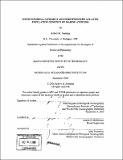| dc.contributor.advisor | Lauren S. Mullineaux. | en_US |
| dc.contributor.author | Jennings, Robert M. (Robert Michael) | en_US |
| dc.contributor.other | Woods Hole Oceanographic Institution. | en_US |
| dc.date.accessioned | 2008-02-28T16:16:33Z | |
| dc.date.available | 2008-02-28T16:16:33Z | |
| dc.date.copyright | c2005. | |
| dc.date.issued | 2005 | en_US |
| dc.identifier.uri | http://dspace.mit.edu/handle/1721.1/39191 | en_US |
| dc.identifier.uri | http://hdl.handle.net/1721.1/39191 | |
| dc.description | Thesis (Ph. D.)--Joint Program in Biological Oceanography (Massachusetts Institute of Technology, Dept. of Biology; and the Woods Hole Oceanographic Institution), 2005. | en_US |
| dc.description | Includes bibliographical references. | en_US |
| dc.description.abstract | The overarching goal of this thesis was to investigate marine benthic invertebrate phylogenetics and population genetics, focused on the phylum Annelida. Recent expansions of molecular methods and the increasing diversity of available markers have allowed more complex and fine-scale questions to be asked at a variety of taxonomic levels. At the phylogenetic level, whole mitochondrial genome sequencing of two polychaetes (the deep-sea tubeworm Riftia pachyptila and the intertidal bamboo worm Clymenella torquata) supports the placement of leeches and oligochaetes within the polychaete radiation, in keeping with molecular evidence and morphological reinvestigations. This re-interpretation, first proposed by others, synonomizes "Annelida" and "Polychaeta", and lends further support to the inclusion of echiurids, siboglinids (previously called vestimentiferans) within annelids, and sipunculans as close allies. The complete mt-genome of C. torquata was then rapidly screened to obtain markers useful in short timescale population genetics. | en_US |
| dc.description.abstract | (cont.) Two quickly evolving mitochondrial markers were sequenced from ten populations of C. torquata from the Bay of Fundy to New Jersey to investigate previous hypotheses that the Cape Cod, MA peninsula is a barrier to gene flow in the northwest Atlantic. A barrier to gene flow was found, but displaced south of Cape Cod, between Rhode Island and Long Island, NY. Imposed upon this pattern was a gradient in genetic diversity presumably due to previous glaciation, with northern populations exhibiting greatly reduced diversity relative to southern sites. These trends in C. torquata, combined with other recent short time scale population genetic research, highlight the lack of population genetics models relevant to marine benthic invertebrates. To this end, I constructed a model including a typical benthic invertebrate life cycle, and described the patterns of genetic differentiation at the juvenile and adult stages. Model analysis indicates that selection operating at the post- settlement stage may be extremely important in structuring genetic differentiation between populations and life stages. Further, it demonstrates how combined genetic analysis of sub-adult and adult samples can provide more information about population dynamics than either could alone. | en_US |
| dc.description.statementofresponsibility | by Robert M. Jennings. | en_US |
| dc.format.extent | 151 p. | en_US |
| dc.language.iso | eng | en_US |
| dc.publisher | Massachusetts Institute of Technology | en_US |
| dc.rights | M.I.T. theses are protected by copyright. They may be viewed from this source for any purpose, but reproduction or distribution in any format is prohibited without written permission. See provided URL for inquiries about permission. | en_US |
| dc.rights.uri | http://dspace.mit.edu/handle/1721.1/39191 | en_US |
| dc.rights.uri | http://dspace.mit.edu/handle/1721.1/7582 | |
| dc.subject | Joint Program in Biological Oceanography. | en_US |
| dc.subject | Biology. | en_US |
| dc.subject | Woods Hole Oceanographic Institution. | en_US |
| dc.subject.lcsh | Benthic animals Larvae | en_US |
| dc.subject.lcsh | Annelida | en_US |
| dc.subject.lcsh | Animal population genetics | en_US |
| dc.title | Mitochondrial genomics and northwestern Atlantic population genetics of marine annelids | en_US |
| dc.type | Thesis | en_US |
| dc.description.degree | Ph.D. | en_US |
| dc.contributor.department | Joint Program in Biological Oceanography. | en_US |
| dc.contributor.department | Woods Hole Oceanographic Institution | en_US |
| dc.contributor.department | Massachusetts Institute of Technology. Department of Biology | |
| dc.identifier.oclc | 65197302 | en_US |
